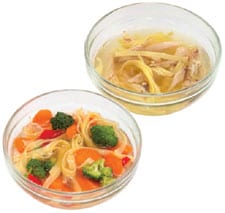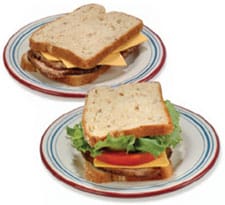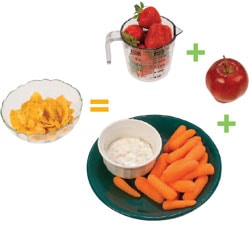Breakfast: Start the Day Right
- Substitute some spinach, onions, or mushrooms for one of the eggs or half of the cheese in your morning omelet. The vegetables will add volume and flavor to the dish with fewer calories than the egg or cheese.
- Cut back on the amount of cereal in your bowl to make room for some cut-up bananas, peaches, or strawberries. You can still eat a full bowl, but with fewer calories.
- Substitute vegetables such as lettuce, tomatoes, cucumbers, or onions for 2 ounces of the cheese and 2 ounces of the meat in your sandwich, wrap, or burrito. The new version will fill you up with fewer calories than the original.
 Add a cup of chopped vegetables, such as broccoli, carrots, beans, or red peppers, in place of 2 ounces of the meat or 1 cup of noodles in your favorite broth-based soup. The vegetables will help fill you up, so you won't miss those extra calories.
Add a cup of chopped vegetables, such as broccoli, carrots, beans, or red peppers, in place of 2 ounces of the meat or 1 cup of noodles in your favorite broth-based soup. The vegetables will help fill you up, so you won't miss those extra calories.
- Add in 1 cup of chopped vegetables such as broccoli, tomatoes, squash, onions, or peppers, while removing 1 cup of the rice or pasta in your favorite dish. The dish with the vegetables will be just as satisfying but have fewer calories than the same amount of the original version.
- Take a good look at your dinner plate. Vegetables, fruit, and whole grains should take up the largest portion of your plate. If they do not, replace some of the meat, cheese, white pasta, or rice with legumes, steamed broccoli, asparagus, greens, or another favorite vegetable. This will reduce the total calories in your meal without reducing the amount of food you eat. BUT remember to use a normal- or small-size plate — not a platter. The total number of calories that you eat counts, even if a good proportion of them come from fruits and vegetables.

- Most healthy eating plans allow for one or two small snacks a day. Choosing most fruits and vegetables will allow you to eat a snack with only 100 calories.
- a medium-size apple (72 calories)
- a medium-size banana (105 calories)
- 1 cup steamed green beans (44 calories)
- 1 cup blueberries (83 calories)
- 1 cup grapes (100 calories)
- 1 cup carrots (45 calories), broccoli (30 calories), or bell peppers (30 calories) with 2 tbsp. hummus (46 calories)
More Tips for Making Fruits and Vegetables Part of Your Weight Management Plan
Canned or frozen fruits and vegetables are good options when fresh produce is not available. However, be careful to choose those without added sugar, syrup, cream sauces, or other ingredients that will add calories.





















One Response to "Simple Ways to Eat More Fruits and Vegetables"